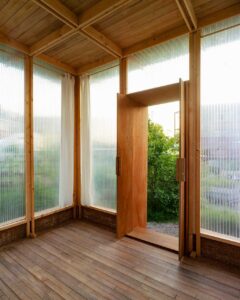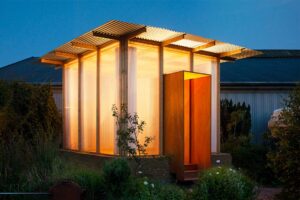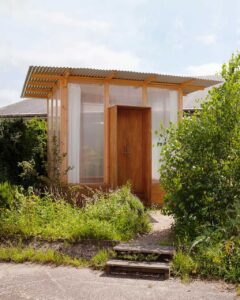Deelnemers / Deelnemers Editie IV
Project
The Circular Pavilion is an experimental and craft-made project. Built as a temporary object, the design aims to be unbuild and recycled again and again. Reused bricks, wood, polycarbonate, and flooring were harvested in the local area of Rotterdam, and given a second life and a new purpose through the project.
The Circular Pavilion express its circularity as an aesthetic assembly. Second-hand materials are upgraded to give them more qualities than in their first use, and applied alongside rammed earth construction. The pavilion was the first time that rammed earth was used in Rotterdam, providing an opportunity to demonstrate the qualities and craftsmanship of recycled earth construction.
The temporary character of the cabin is invisible, but the object can easily be removed and rebuilt somewhere else.
The intention is for the pavilion to be the first in a series of prototypes, providing a 1:1 catalogue of details of reuse, a handbook of ways to reuse and combine old material. In January 2022, the pavilion was carefully deconstructed and all the components were transported to Brabant. In May 2022, all the deconstructed material will be rebuilt into a new architectural form, demonstrating the capacity of reuse to compose new, resilient architectural forms.
In its first construction, the cabin arose in the heart of a wild garden in Rotterdam. Each element and detail were visible from inside and outside, offering a permanent dialogue with the garden. The door was lifted from the ground and attached to the transparent cube.The rammed earth base was a wall and a floor, mixing functions, emphasising its archetypal form. The aluminum roof floated and revealed the timber structure and the transparency of the facade. The architecture dialogued between mass, transparency, time and durability. The design of the original Circular Pavilion followed a clear process, always involving hands-on detailing, from maquette to the final built object. This cabin has been self built, allowing on-site detailing, and even during construction, every detail was refined by building a mock-up and adapting the design based on the second-hand materials available.
The design was thought of as a flexible structure that all materials could fit into, always using the same timber section. The neutrality of the facade allows a dialogue between the surrounding nature and the architecture. The aesthetic of the rammed earth base emphasises the contrast between natural and artificial materials. The acrylate can be perceived as glass, reflecting the colour of the sky or showing the continuity of the structure from outside to inside. As an ensemble, this temporary object highlighted the potential of circular and re-used materials.
The rammed earth walls were made with recycled earth from Bruxelles ( Kastar ) and supported the entire structure. This raw material can be re-used anytime to build a new wall or to grow plants in a garden. The cement bricks and the grind come from local gardens. The wooden floor and celling are reclaimed from old sports hall flooring. The acrylate comes from a chicken farm. The entrance is made of re-used rare plywood. All the materials were cleaned, sanded or polished to reveal their qualities and values.
The pavilion takes position in an industrial context and is directly exposed to the sea climate. The rammed earth wall will erode over the time and will highlight the monolithic character of the base. This object sits in dialogue with living matter and the surrounding garden. Additionally, the project establishes a strong connection with craft and customised details: the furnitures are especially designed for the pavilion and use the same wooden section as the timber structure of the cabin. The cabin is a mix use space that can be used as a pavilion, a sleeping cabin, a retreat space or a winter garden. Designed as a generous volume, the earth base and the elevated floor offer a dry and fresh climate, guaranteeing a comfortable environment in every season. When opened up, the pavilion’s height and spacious character connects the user to the garden outside, or, curtains can be closed to give intimacy to the visitor.
Impact
Cities produce a never-ending supply of “waste” yet the building industry imports raw materials from the other side of the world, despite the economic and ecological pressures we face. At a time when “Being less bad is not enough”, the way we build needs to change. Architects have the capacity to answer calls for climate action in the construction industry and induce changes by designing carbon neutral and by looking for a re-materialisation of the way we build.
Radical material reuse is therefore essential in the move towards a sustainable construction industry. Though designing sustainability is primarily a question of matter and energy, it has social, spatial and economic impacts. An example can be seen in my understanding of re-use as a new local resource, harvested directly from the urban fabric. This urban mining primarily has ecological benefits by reducing raw material use while also developing new local, affordable and circular supply chains, supporting local communities. My practice looks for methods of working with this undefined urban catalogue in order to prototype and propose possible assemblies.
With studio ACTE, I want to achieve low-tech and beautiful architectures that embrace resources, cultures and people. I am trained as an Architect, and in my career I have developed substantial expertise across scales and programmes of building, as well as interdisciplinary skills in crafts of making. I previously worked as a Project Leader on large building projects (Atelier Kempe Thill & ZUS). With studio ACTE, I focus on small scale architectures which enable the affordable material research and experimentation that is integral to my process. For example, The Circular Pavilion provided an opportunity to dive into material assembly. By re-using earth, wood, stones and plastics I was able to test the capacity of building with local materials collected in the immediate context. I experimented with a method that can now be scaled up and applied to larger projects. The pavilion grounded my practice, and lead to several opportunities in teaching, lectures and new projects.
Creatief Ondernemerschap
In practice, Studio ACTE designs through model-making and prototyping, involving materials, crafts and hands-on research during the entire concept and building process. Physical and three-dimensional experimentation are cornerstones from which to explore and increase our knowledge. The studio believes that thinking circular demands a hands-on dedication in order to find new ways of re-using matter.
In the wake of the latest climate report from the IPCC of the United Nations, Architecture must carry the necessary shift towards positive ways of building and living by learning new materials. In a broader way, Studio ACTE believe into new form of producing architecture, where matter is the core of a resilient building process. Researching sustainable materials while also applying them in build projects is the first step to cultivating new practices – but it is not often possible in standard commissions. For us, creative entrepreneurship therefore means actively practicing. Through research and identifying where there is a project need, we seek to generate our own opportunities in order to allow the practice to cross disciplines and work in a way that considers design process, experiment and material research, and building as one. Only in this way can radical new ways of practicing and constructing things emerge.


